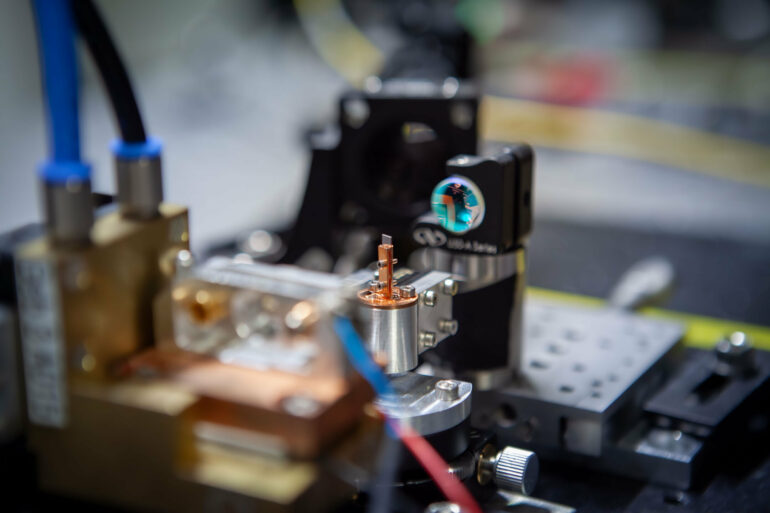Measuring tiny magnetic fields, such as those generated by brain waves, enables many new novel opportunities for medical diagnostics and treatment. The research team led by Dr. Jan Jeske at Fraunhofer IAF is working on a globally innovative approach to precise magnetic field measurements: Laser Threshold Magnetometry.
The researchers have now combined an NV diamond and a laser diode in a resonator, successfully demonstrating the sensor system with two active media for the first time. The paper, “Dual-media laser system: nitrogen vacancy diamond and red semiconductor laser,” has been published in Science Advances and represents significant progress in the research project, NeuroQ.
Quantum sensors based on nitrogen-vacancy (NV) centers in diamond are already widely used for precise magnetic field measurements at room temperature and in background magnetic fields. Laser threshold magnetometry (LTM) is a novel research approach to measure extremely low magnetic fields in the femtotesla (fT) to picotesla (pT) range.
In addition, LTM allows measurements with a high dynamic range without the need to suppress background fields. These features make laser threshold magnetometry particularly useful for medical applications, such as measuring biomagnetic signals from the brain or heart.
Laser threshold magnetometry principle
The scientific principle of LTM has already been extensively studied in theory. Since then, researchers at the Fraunhofer Institute for Applied Solid State Physics IAF have been working on the realization of the first laser threshold magnetometer.
The basic concept is to develop a laser from NV centers and to use the laser light, which reacts to magnetic fields, to obtain precise information about the strength and direction of a magnetic field. The laser threshold is the point at which the laser starts or stops emitting light.
As magnetic fields near the laser threshold have a very strong effect on the signal, they can be measured very precisely at this point. Compared to fluorescent light, laser signals can be measured much more accurately and over a wider dynamic range.
In 2022, researchers at Fraunhofer IAF succeeded in demonstrating the world’s first magnetic field-dependent light amplification of NV centers. Due to the external laser source, however, the laser threshold of the NV centers could not yet be realized.
First demonstration of the laser threshold
In the current results, the researchers combined the NV diamond with a second laser medium, a laser diode for additional light amplification, in an optical resonator. This enabled them to demonstrate the laser threshold for the first time. Depending on how strongly the NV centers were pumped, the laser system switched on or off.
“The results are a breakthrough for the development of laser threshold magnetometry. On this basis, sensors with up to 100 percent contrast, strong light signals and a wide range of measurable magnetic field strengths can be realized in the future,” says Dr. Jan Jeske, researcher in the field of quantum sensor technology at Fraunhofer IAF.
The work of first author Lukas Lindner shows an early stage of the lighthouse project “Laser threshold magnetometer for neuronal communication interfaces,” or NeuroQ for short. The NeuroQ project team is currently working on further developing the innovative NV diamond laser system, which is currently in the patent application process, and increasing its sensitivity.
More information:
Lukas Lindner et al, Dual-media laser system: Nitrogen vacancy diamond and red semiconductor laser, Science Advances (2024). DOI: 10.1126/sciadv.adj3933
Provided by
Fraunhofer-Institut für Angewandte Festkörperphysik IAF
Citation:
Highly sensitive quantum sensors for medicine: First successful demonstration of a dual-media NV diamond laser system (2024, October 8)



